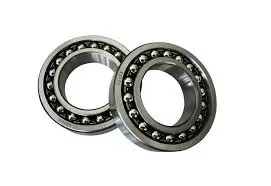
10 月 . 19, 2024 12:24 Back to list
Understanding Single Row Angular Contact Bearings for Improved Performance and Precision
Understanding Single Row Angular Contact Bearings
Single row angular contact bearings are a crucial component in various mechanical systems, particularly in applications requiring high precision and load capacity. These bearings are designed to accommodate combined loads, featuring a unique construction that allows them to handle axial and radial forces simultaneously. Their design consists of an outer ring, an inner ring, balls, and a cage. Due to their specific geometry, these bearings can support high-speed operations and are widely utilized in industries such as automotive, aerospace, and machinery manufacturing.
Design Features
The primary distinguishing feature of single row angular contact bearings is their raceway geometry. Unlike radial ball bearings, which allow for purely radial loads, angular contact bearings are designed to accept loads at an angle relative to the bearing axis. This ability grants them the capacity to handle a combination of axial and radial loads, with the axial load direction being specific to the angle of contact.
The contact angle in a single row angular contact bearing directly influences its performance. Generally, the contact angle can range from 15 to 40 degrees, with larger angles providing higher axial load capacity. Bearings with larger contact angles are frequently used in applications where heavy axial loads are prevalent, while those with smaller angles are more suited for high-speed applications where radial loads are dominant.
Benefits of Single Row Angular Contact Bearings
1. Versatile Load Handling One of the primary advantages of single row angular contact bearings is their ability to handle both axial and radial loads. This makes them highly versatile in various applications, including high-speed machinery, pumps, and conveyor systems.
2. Compact Design These bearings have a compact structure, making them suitable for applications with space constraints. The integration of multiple load paths also enhances the reliability and longevity of the bearing, even in high-stress conditions.
single row angular contact bearing

3. Reduced Friction and Heat Generation With their optimized design, single row angular contact bearings offer reduced friction, which translates to lower heat generation during operation. This feature helps in maintaining performance and preventing premature wear, thus prolonging the lifespan of the bearings.
4. High Accuracy and Precision In precision applications, such as in CNC machines and robotics, the use of single row angular contact bearings ensures high levels of accuracy. Their ability to maintain tight tolerances under various load conditions enhances the overall performance of the equipment.
5. Cost-Effective Solution Although the initial cost of these bearings may be higher than traditional bearings, their durability, low maintenance requirements, and extended service life often result in lower overall operating costs.
Applications
Single row angular contact bearings are used in a myriad of applications across different industries. Common sectors include
- Machine Tools Employed in spindles and precision bearings to ensure smooth operation under heavy loads. - Electric Motors Used in various configurations to support high-speed rotor assembly while managing significant axial loads. - Automotive Found in wheel hubs and gearboxes, providing longevity and reliability under demanding conditions. - Aerospace Essential in aircraft engines and landing gear systems due to their ability to withstand extreme conditions and varying loads.
Conclusion
In summary, single row angular contact bearings are integral components in modern machinery, enabling efficient and precise operations. Their unique design allows for the handling of both axial and radial loads, making them suitable for a wide range of applications. With benefits such as versatile load handling, compact design, and high precision, these bearings stand out in the field of industrial engineering. As technology continues to advance, the demand for such high-performance bearings will likely increase, leading to further innovations in their design and applications. Understanding their functionalities and advantages can assist engineers and designers in selecting the right bearing solutions for their specific needs, ultimately enhancing performance and reliability in their mechanical systems.
Latest news
-
Unlocking Efficiency with Spherical Roller Bearings
NewsOct.29,2024
-
The Ultimate Guide to Thrust Ball Bearings
NewsOct.29,2024
-
The Power of Thrust Roller Bearings: Engineered for Excellence
NewsOct.29,2024
-
The Power of Deep Groove Ball Bearings for Your Application Needs!
NewsOct.29,2024
-
The Power and Performance of Cylindrical Roller Bearings
NewsOct.29,2024
-
High-Quality Ball Bearing Manufacturing Machines
NewsOct.29,2024
